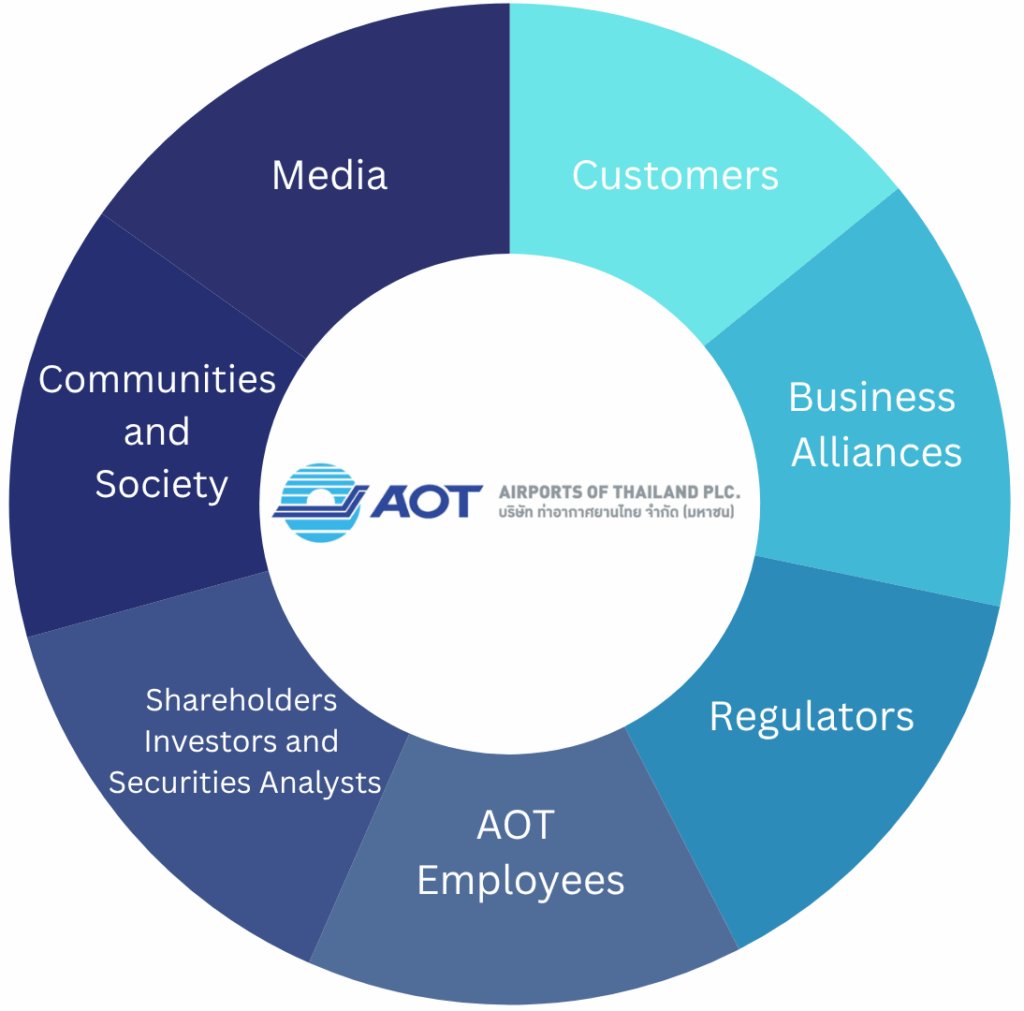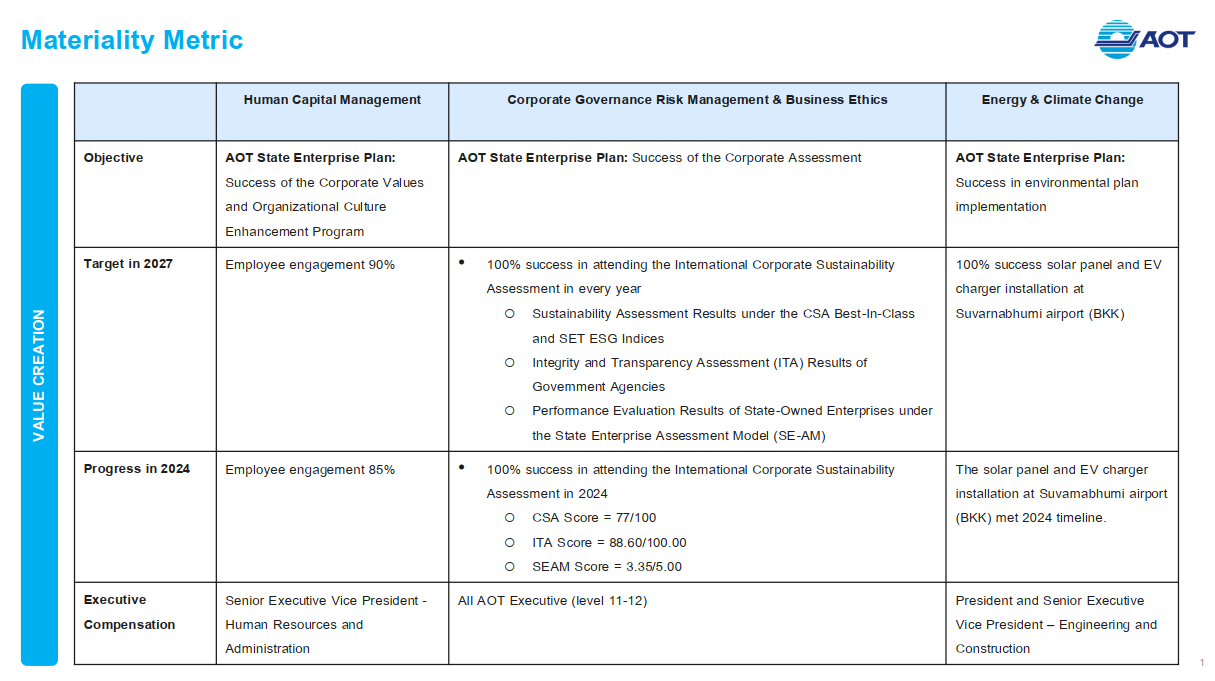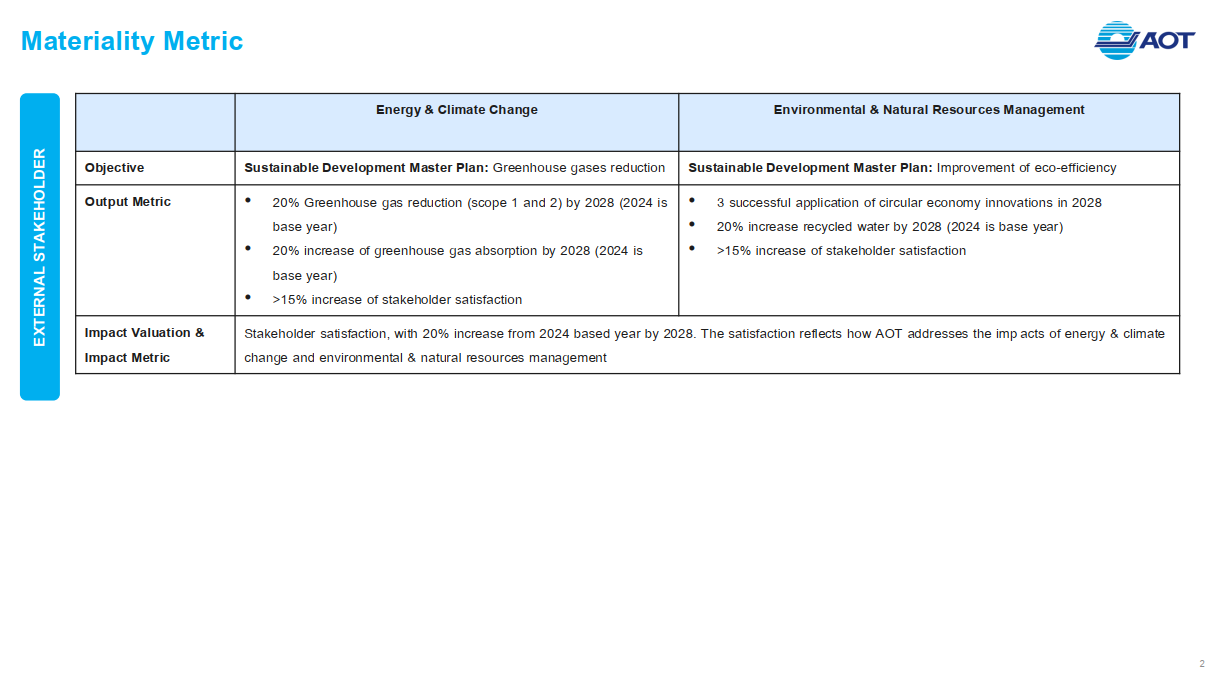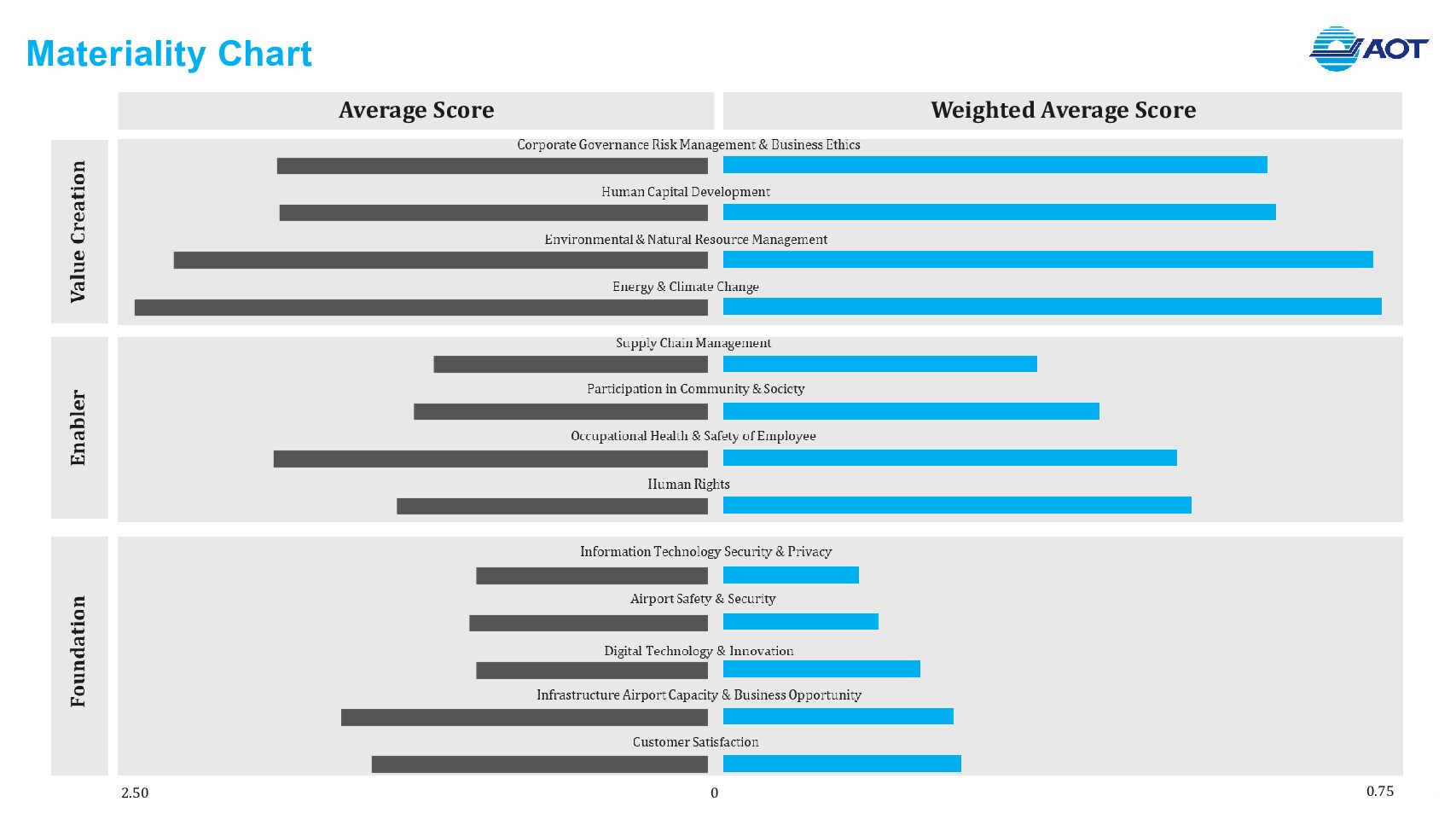Management Approch
Reporting Process
The determination of sustainability reporting content is aligned with Airports of Thailand’s (AOT) enterprise-wide risk management approach, the Global Reporting Initiative (GRI) Standards 2021, and the Double Materiality principle. AOT reviews and defines material sustainability topics on an annual basis.
In 2024 (Fiscal Year 2024), AOT reviewed its material sustainability issues by taking into consideration various factors such as changes in applicable laws, regulations, national and international assessment standards, as well as emerging global trends in both sustainability and the aviation business. To address the expectations of all stakeholder groups, AOT conducted an analysis of both positive and negative impacts arising from its operations, as well as external risks and opportunities that may affect the organization’s performance.
The materiality assessment process comprises four key steps:
Step 1: Review of Previous Material Sustainability Issues
AOT gathered and analyzed data across all business activities—including airport services and capacity expansion at its six airports—along with the interests of its seven key stakeholder groups (customers; shareholders, investors, and analysts; business alliances; local communities and society; regulatory authorities; media; and AOT personnel) throughout the value chain. In addition, AOT reviewed economic, environmental, and social issues relevant to its operations to gain a comprehensive understanding of the organization’s context. This served as a foundation for reviewing and updating material sustainability issues.
Benchmarking was also conducted against peer companies with similar business operations, as well as national and international standards, emerging trends, and assessment frameworks. This comparative analysis ensured that AOT’s material topics remain up to date and aligned with evolving market expectations and global sustainability standards.
Step 2: Impact Identification
AOT analyzed and identified the economic, environmental, and social impacts resulting from its business operations. This process covered both positive and negative impacts—whether direct or indirect—arising from various activities carried out by AOT. Impact identification was conducted through stakeholder engagement activities, including workshops and opinion surveys, to ensure a clear understanding of the extent to which these impacts affect stakeholders and how they align with the Sustainable Development Goals (SDGs).
Step 3: Impact Analysis
AOT developed a weighted heat map based on calculated scores for each material sustainability topic. This analysis incorporated benchmarking of peer companies and the review of national and international standards, trends, and assessment frameworks. References included the Dow Jones Sustainability Indices (DJSI), the United Nations Global Compact (UNGC), the Sustainability Accounting Standards Board (SASB), and the SET ESG Ratings. AOT also began preparing for the transition of its ESG assessment framework from SET ESG Ratings to FTSE Russell ESG Scores, as initiated by the Stock Exchange of Thailand.
Step 4: Consolidation of Material Sustainability Issues
Based on AOT’s 2024 review and assessment of material sustainability issues, the issues were prioritized into three levels: Highest Priority, High Priority, and Priority. This categorization enables AOT to effectively plan and respond to sustainability challenges and opportunities. The finalized material issues were presented to the President for approval and endorsement prior to public disclosure.

Material Issues for Enterprise Value Creation
In 2024, AOT identified and reviewed a total of 13 material sustainability issues, taking into consideration the expectations and concerns of both internal and external stakeholders. These issues comprehensively cover the economic, social, and environmental dimensions as follows:
| Priority Level | Material Issues | SDGs |
|---|
| Value Creation | 1. Energy and climate changes | |
| 2. Environmental and natural resource management | ||
| 3. Human Capital development | ||
| 4. Corporate governance, risk management and business ethics* | ||
| Enabler | 5. Human rights | |
| 6. Occupational health and safety of employees | ||
| 7. Participation in communities and society |
|
|
| 8. Supply chain management |
|
|
| Fundamentals | 9. Customer satisfaction | |
| 10. Infrastructure, airport capacity and business opportunity | ||
| 11. Digital technology and innovations |
|
|
| 12. Airport safety and security |
|
|
| 13. Information technology security and privacy |
|
Remarks: * The issues on corporate governance, risk management and business ethics are the fundamental issues of business operations that have already been disclosed in the Annual Registration Statement/Annual Report (Form 56-1 One Report). Therefore, the information is not included in this report.
1. Human Capital development
AOT’s business operations rely on a knowledgeable and capable workforce. To ensure employees can perform to their full potential, the Company places strong emphasis on comprehensive human capital management. This includes fostering favorable employment conditions, conducting performance-based evaluations, offering appropriate incentives, and promoting well-being without discrimination.
This approach forms the foundation of AOT’s human resource strategy, which encompasses talent development, attraction and retention of high-potential employees, fair labor practices, competitive compensation and benefits, and respect for diversity and inclusion. AOT is committed to being an employer that provides meaningful work and supports the holistic well-being of its workforce.
In doing so, AOT actively promotes human rights by ensuring fair employment, equal treatment, appreciation of individual differences, and upholding the freedom of association and collective bargaining.
| Classification | Material Issues for Enterprise Value Creation |
| Risk |
|
| Opportunity | Human resource development enhances competitive advantage through service excellence and employee-driven innovation, which in turn contributes to customer and airport user satisfaction. |
| Business Strategy |
|
| Corporate Objectives and Leadership Performance Indicators | Success of the Corporate Values and Organizational Culture Enhancement Program |
2. Corporate governance, risk management and business ethics
The AOT Board of Directors is committed to upholding the Company’s corporate governance principles, in accordance with AOT’s Corporate Governance Code, the best practices for directors of listed companies, as well as the rules, regulations, and guidelines set forth by the Stock Exchange of Thailand (SET) and the Securities and Exchange Commission (SEC).
Moreover, the Board continually strives to enhance AOT’s corporate governance framework to align with international best practices. Good corporate governance is crucial to building trust among all stakeholders. Shareholders and investors are assured of transparent and fair management practices, which contribute to long-term value creation and investment returns. Simultaneously, customers and service users benefit from high-quality, safe, and equitable services, along with efficient channels for feedback and complaint resolution. Employees and personnel also gain from these governance practices, ensuring fairness and fostering a supportive work environment.
| Classification | Material Issues for Enterprise Value Creation |
| Risk |
If AOT fails to comply with national regulations, disregards business ethics, and is unable to manage corporate risks effectively, it may be exposed to the following consequences:
|
| Opportunity | |
| Business Strategy |
|
| Corporate Objectives and Leadership Performance Indicators |
|
3. Energy and climate changes
Efficient energy use and active participation in mitigating climate change are key factors contributing to AOT’s long-term revenue generation. These issues are of particular importance to sustainability-focused investors (ESG Investing). In addition, energy and climate change efforts can help reduce AOT’s long-term operational costs—for example, through the adoption of solar energy and preparations for regulatory changes regarding greenhouse gas emissions in Thailand.
| Classification | Material Issues for Enterprise Value Creation |
| Risk |
Energy and climate change risks can be categorized into five aspects:
|
| Opportunity | Participation in addressing climate change and reducing greenhouse gas emissions through the use of green energy enhances long-term investment appeal for ESG-focused investors. |
| Business Strategy |
|
| orporate Objectives and Leadership Performance Indicators |
|
Materiality Issues for External Stakeholders
1. Energy and climate changes
The management and expansion of airport infrastructure require substantial energy consumption, which contributes to greenhouse gas emissions—both directly from AOT’s operations and indirectly through its supply chain. These emissions are key contributors to climate change, which increasingly manifests in more frequent and severe natural disasters, exceeding historical averages. Therefore, effective energy and climate management by AOT not only mitigates these impacts on communities and society, but also addresses the expectations of key stakeholders—including shareholders, investors, securities analysts, and regulatory bodies—who are increasingly focused on sustainable investments and compliance with international sustainability requirements.
| Classification | Material Issues for External Stakeholders |
| Source of Impact | AOT’s operations—both at the airport level and by airport users—require significant energy consumption and emit greenhouse gases. |
| Impact | Greenhouse gas emissions contribute to climate change, which in turn affects communities through long-term impacts such as air pollution and the increasing severity of natural disasters. |
| Impact Assessment |
|
2. Environmental and natural resource management
Airport operations, along with the development and expansion of infrastructure, require systematic management to address the environmental impacts arising from business activities. This is essential for mitigating both positive and negative effects on various stakeholder groups, particularly regulatory authorities, shareholders, investors, and securities analysts—who hold significant interest in and expectations for AOT’s management practices.
AOT places strong emphasis on environmental impact management, focusing on key issues including noise management, air quality, water and wastewater, waste management, and biodiversity. These environmental aspects have the potential to create far-reaching impacts in various forms. Accordingly, AOT recognizes the importance of managing potential risks through the implementation of established environmental management measures and plans to ensure that operations align with long-term environmental sustainability.
| Classification | Material Issues for External Stakeholders |
| Source of Impact | AOT’s operations—both airport infrastructure and user activities—require significant consumption of natural resources, and generate various forms of waste and air/noise pollution. |
| Impact | Surrounding communities are exposed to air and noise pollution from airport operations, as well as water shortages during drought periods. Additionally, communities near AOT's waste disposal sites may experience adverse environmental effects. |
| Impact Assessment |
|
AOT has developed a comprehensive action plan, established relevant targets, and implemented performance indicators to assess employees across all levels—from the Board of Directors and executives to operational staff—on various material sustainability topics. These measures aim to drive performance that mitigates potential negative impacts on the organization while enhancing development opportunities and strengthening the international competitiveness of Thai airports. Further details are available in the AOT Sustainability Report 2024 and on AOT’s Sustainability Development website.

AOT's Stakeholders
AOT identifies and prioritizes key stakeholders by assessing individuals or groups that may be significantly impacted by, or have influence over, the company’s operations throughout its value chain. Stakeholder prioritization has been conducted based on material influence and exposure, with the company ranking its primary stakeholders as follows:
Customers
AOT Personnel
Operational Partners
(Source: AOT Stakeholder Engagement Master Plan FY2024–FY2027 [Revised FY2024 Edition], Stakeholder Analysis and Prioritization, p. 89)
In addition, AOT defines key airport community areas using criteria such as Environmental Impact Assessments (EIA), Airport Emergency Plans, and Noise Contour assessments. The company engages with each stakeholder group through a structured management and response framework based on the following four principles:
- Stakeholder Access and Relationship Building
- Learning and Case Study Development
- Operational Planning and Business Impact Assessment
- Continuous Adaptation and Process Improvement
Stakeholder Impact Boundary
AOT identifies the stakeholder impact boundaries for each material sustainability issue to ensure effective management and alignment with the expectations of each key stakeholder group, as follows:
| Material Sustainability Topics | Scope of Stakeholder Impact | |||||||
|---|---|---|---|---|---|---|---|---|
| Internal | External | |||||||
| AOT Employees | Customers | Business Alliances | Regulators | Communities & Society | Media | Shareholders, Investors, and Analysts | ||
| Economic Dimension | Corporate Governance | ✓ | - | ✓ | ✓ | - | - | ✓ |
| Risk Management | ✓ | - | ✓ | ✓ | - | - | ✓ | |
| Business Ethics | ✓ | ✓ | ✓ | ✓ | ✓ | ✓ | ✓ | |
| Infrastructure, Capacity, and Business Opportunities | - | ✓ | ✓ | - | ✓ | - | ✓ | |
| Supply Chain Management | - | ✓ | ✓ | - | ✓ | ✓ | ✓ | |
| Digital Technology and Innovation | ✓ | ✓ | ✓ | ✓ | ✓ | - | ✓ | |
| Information Security and Data Privacy | ✓ | ✓ | ✓ | ✓ | ✓ | ✓ | ✓ | |
| Social Dimension | Customer Satisfaction | - | ✓ | ✓ | - | - | ✓ | - |
| Airport Safety and Security | ✓ | ✓ | ✓ | ✓ | ✓ | ✓ | - | |
| Occupational Health and Safety | ✓ | ✓ | ✓ | ✓ | ✓ | - | - | |
| Human Rights | ✓ | ✓ | ✓ | ✓ | ✓ | ✓ | ✓ | |
| Human Capital Development | ✓ | - | - | - | - | - | - | |
| Community and Social Engagement | ✓ | - | - | ✓ | ✓ | ✓ | - | |
| Environmental Dimension | Energy and Climate Change | - | ✓ | ✓ | ✓ | ✓ | ✓ | ✓ |
| Natural Resource and Environmental Management | - | ✓ | ✓ | ✓ | ✓ | ✓ | ✓ | |
Engagement with the Company’s Top Three Priority Stakeholder Groups (Customers, Employees, and Business Alliances)
1. “Think Out Loud” Project and “Think Out Loud” under the AOT Open Innovation: Hackathon in Collaboration with Academic Institutions
The project aims to encourage both internal personnel and external stakeholders to engage in analytical thinking and brainstorming activities to develop innovative ideas that can be further refined and applied. It focuses on solving existing operational and service delivery challenges, as well as improving overall organizational efficiency.
This initiative also serves as a platform for open innovation, allowing external stakeholders to actively participate in generating innovative ideas. It fosters collaboration between AOT and external entities to develop innovations that truly respond to stakeholder needs.
In addition, AOT has partnered with academic institutions such as Thammasat University, Kasetsart University, and the Civil Aviation Training Center to collect and enhance open innovation concepts. The collaboration includes joint efforts in analyzing passenger data to develop socially and environmentally conscious business innovations, as well as enhancing passenger service quality at Don Mueang International Airport.
2. “Innolution” Creative Innovation Contest
This project aims to motivate innovation development and foster creative ideas within the organization. It also seeks to raise awareness of the benefits that innovation can bring to individuals’ work processes and organizational operations, ensuring sustainable outcomes.
The target participants include AOT employees and stakeholders operating within airport premises, such as airlines, business operators, governmental agencies, and temporary employees. Participants engage in an innovative idea contest that leads to the further development of innovative solutions. Additionally, the project aims to build collaborative networks to enhance airport services across all six airports under AOT’s management.
The Innovation Strategy Department, responsible for the project, will integrate feedback and suggestions from executives, employees, and temporary staff to comprehensively enhance AOT’s innovation initiatives. This approach will promote AOT’s image, further establishing the company as an innovative organization.
The project was honored by Associate Professor Dr. Teera Chiasiripongkul, AOT Board Member and Chairman of the Knowledge Management and Innovation Committee, who presided over the opening ceremony, along with Dr. Keerati Kitmanawat, AOT President, who delivered the opening remarks.
3. Development Crew
This project is designed to further develop innovative ideas into prototype innovations that can be practically implemented in accordance with AOT’s innovation process. The selected initiatives receive support in terms of budget and information technology from relevant departments.
AOT has established clear selection criteria for innovative ideas from both internal and external stakeholders. These ideas must align with AOT’s strategic direction and contribute to the organization’s value creation. Each innovation undergoes a structured evaluation process, following AOT’s defined development stages.
Moreover, during the meetings of AOT’s Knowledge Management and Innovation Management Committee, the progress of innovation development is formally reported. The committee’s resolutions include approval to proceed with the innovation development process from the Development stage to the Implementation stage, enabling real-world application of the innovation outcomes.
4. Customers Relation Management : CRM
This initiative aims to foster strong and long-lasting relationships with stakeholders through an effective service strategy. The focus is on enhancing communication, managing airport facilities, and delivering services that meet users’ expectations. Furthermore, it promotes collaboration with government agencies, private sector entities, and commercial operators within the airport to create a business-friendly environment.
AOT organizes engagement activities to strengthen stakeholder relationships, such as appreciation events and networking activities. These events are attended by executives and representatives from government agencies, state enterprises, airlines, and airport business operators, as a gesture of appreciation for their continued support. The events typically feature musical performances, recreational activities, and prize giveaways, offering valuable opportunities for dialogue and collaboration toward future cooperation.
In addition, AOT emphasizes the importance of clear communication, effective coordination, and active listening to stakeholder concerns. These insights are used to inform future planning to mitigate potential impacts. The initiative also encourages cooperation among commercial operators within the airport, promoting mutual understanding and collaboration toward sustainable business operations.
Stakeholder Engagement and Response Process of AOT
AOT engages with each stakeholder group through four key relationship-building tools.
- Engagement and relationship-building
- Learning and case study development
- Defining operational approaches and assessing business impacts, and
- Applying lessons learned and continuously improving processes.
| Stakeholder | Engagement Methods | Expectations | Responses to Expectations | |
|---|---|---|---|---|
| (1) Customers |
|
|
|
|
| (2) Business Alliances |
|
|
|
|
| (3) Shareholders, Investors, and Securities Analysts |
|
|
|
|
| (4) Regulatory Agencies |
|
|
|
|
| (5) Communities and Society |
|
|
|
|
| (6) AOT Personnel |
|
|
|
|
| (7) Media Group |
Media refers to organizations, institutions, individuals, or groups of individuals that influence AOT by serving as intermediaries in disseminating information about AOT’s operations to the public through various channels such as:
Classified into two categories:
|
|
|
|



